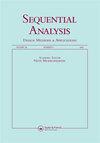Three-stage minimum risk point estimation with termination defined via Gini’s mean difference
IF 0.6
4区 数学
Q4 STATISTICS & PROBABILITY
Sequential Analysis-Design Methods and Applications
Pub Date : 2022-01-02
DOI:10.1080/07474946.2022.2043051
引用次数: 0
Abstract
Abstract In this article, we revisit the classic inference problem of minimum risk point estimation for an unknown normal mean when the variance also remains unknown. We propose an alternative three-stage sampling procedure with termination defined via Gini’s mean difference rather than the traditional sample standard deviation. A number of asymptotic properties are investigated both theoretically and empirically. An extensive set of simulations is conducted to demonstrate the remarkable performance of the new procedure. For practical purposes, we also include illustrations using real data sets on the number of days marigold seeds need to flower.通过基尼均值差定义终止的三阶段最小风险点估计
摘要在这篇文章中,我们重新讨论了当方差仍然未知时,未知正态均值的最小风险点估计的经典推理问题。我们提出了一种替代的三阶段抽样程序,其终止通过基尼平均差而不是传统的样本标准差来定义。从理论和实证两方面研究了一些渐近性质。进行了一系列广泛的模拟,以证明新程序的显著性能。出于实用目的,我们还提供了使用真实数据集的万寿菊种子开花天数的插图。
本文章由计算机程序翻译,如有差异,请以英文原文为准。
求助全文
约1分钟内获得全文
求助全文
来源期刊

Sequential Analysis-Design Methods and Applications
STATISTICS & PROBABILITY-
CiteScore
1.40
自引率
12.50%
发文量
20
期刊介绍:
The purpose of Sequential Analysis is to contribute to theoretical and applied aspects of sequential methodologies in all areas of statistical science. Published papers highlight the development of new and important sequential approaches.
Interdisciplinary articles that emphasize the methodology of practical value to applied researchers and statistical consultants are highly encouraged. Papers that cover contemporary areas of applications including animal abundance, bioequivalence, communication science, computer simulations, data mining, directional data, disease mapping, environmental sampling, genome, imaging, microarrays, networking, parallel processing, pest management, sonar detection, spatial statistics, tracking, and engineering are deemed especially important. Of particular value are expository review articles that critically synthesize broad-based statistical issues. Papers on case-studies are also considered. All papers are refereed.
 求助内容:
求助内容: 应助结果提醒方式:
应助结果提醒方式:


